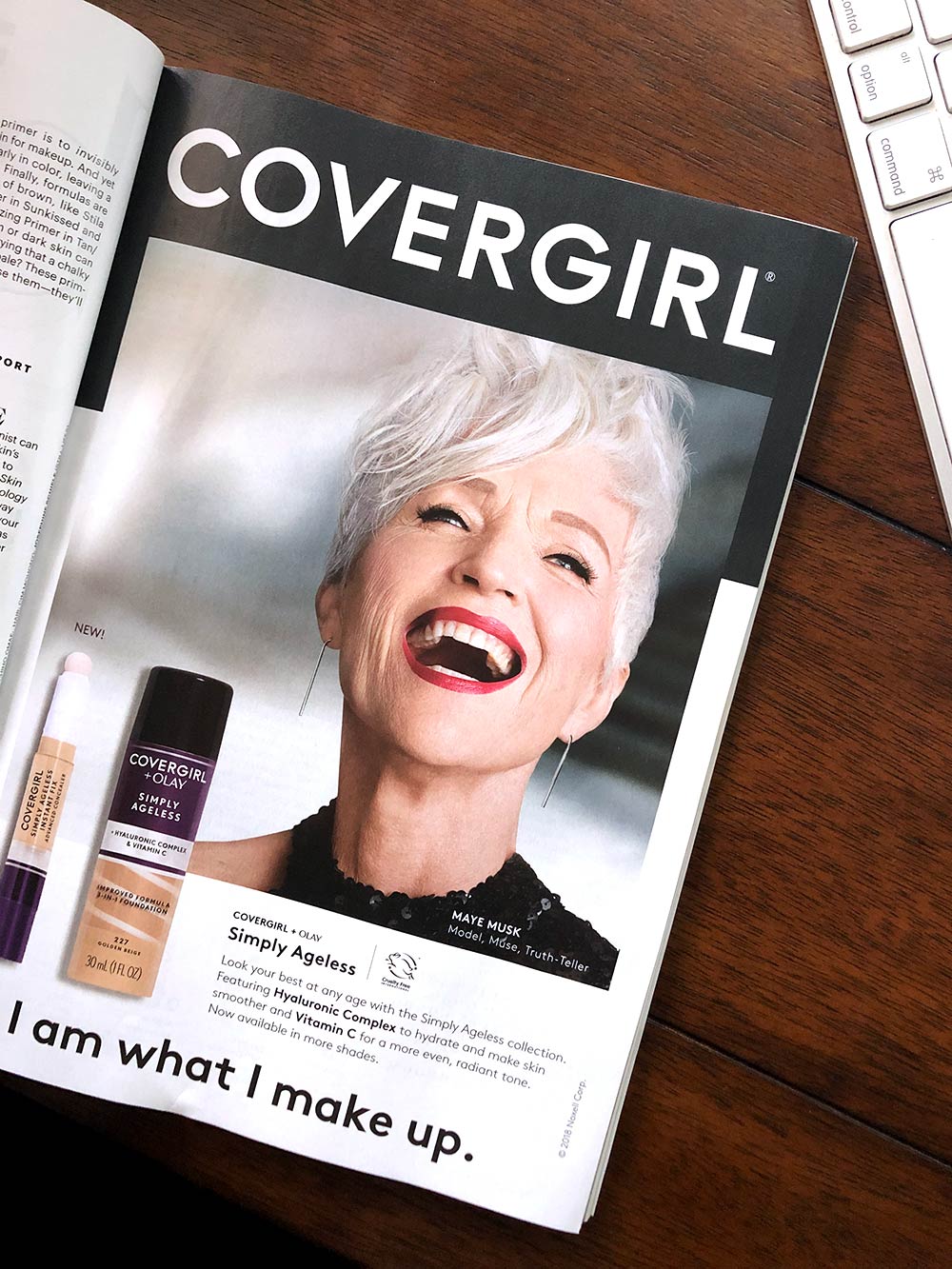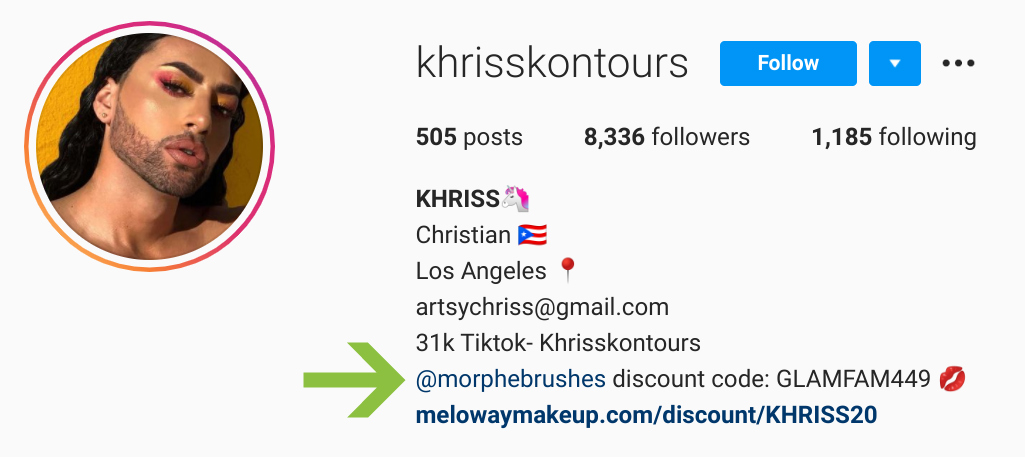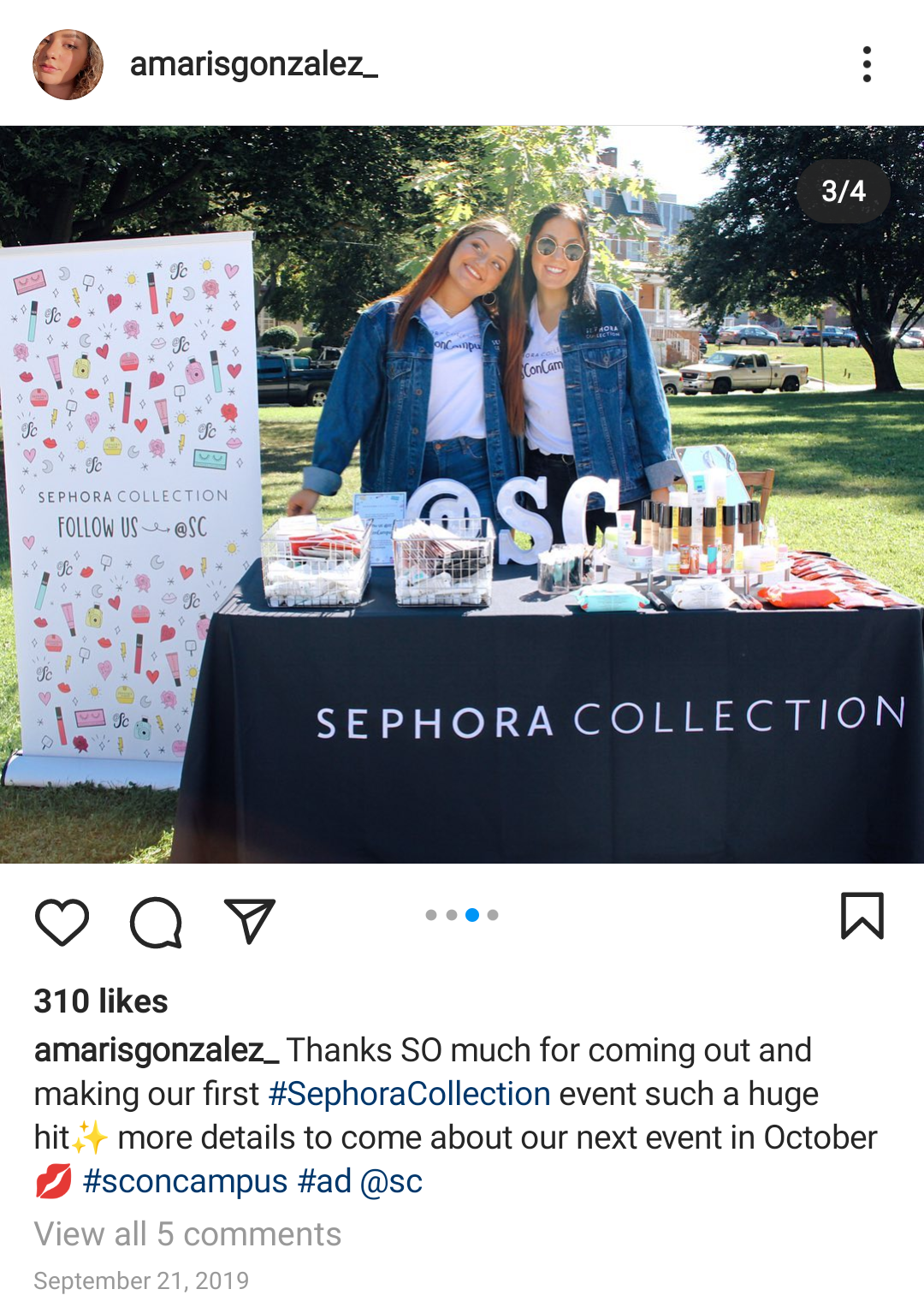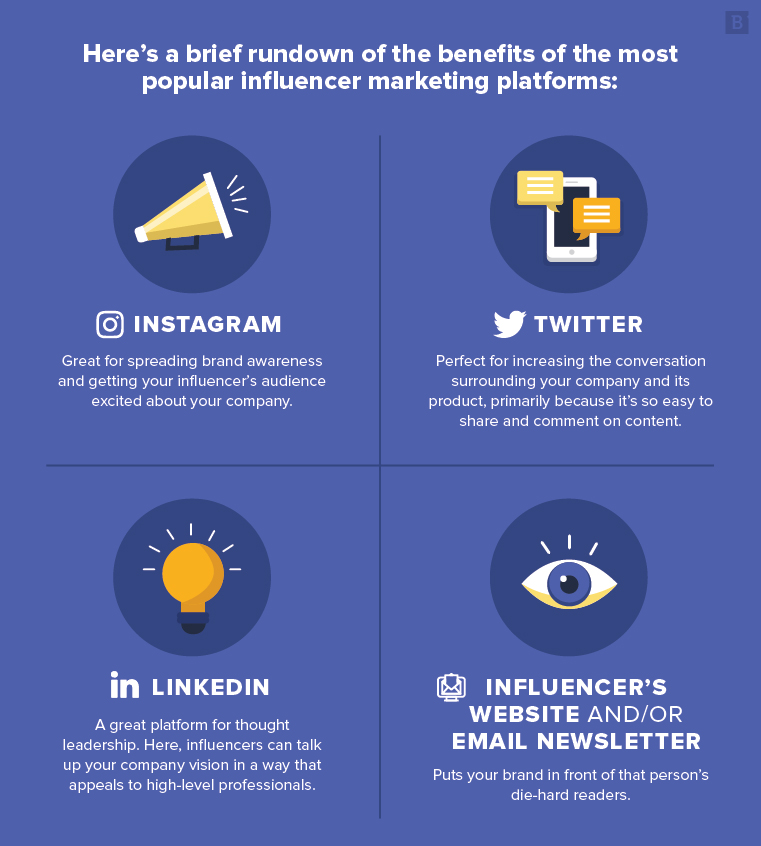For many businesses, a brand ambassador program can be a fruitful way to reach new audiences, attract new customers and boost the bottom line. But how does brand ambassadorship work, and what is a brand ambassador, anyway?
Here’s what you need to know about weaving this popular promotional tactic into your company’s overall marketing strategy.
What is a Brand Ambassador — and Who Can Be One?
Working in partnership with an organization, a brand ambassador is someone who represents and promotes that business’ brand to various audiences. Their positive spokespersonship is intended to boost brand awareness and help convert new customers. Additionally, they’re typically rewarded in some way for their efforts.
Brands can work with many different types of brand ambassadors, depending on the level of exposure they’re looking for and the budget they have to spend on this type of program. Let’s look at just how varied the brand ambassadorship umbrella can be.

The Celebrity
- Serves as a spokesmodel and “the face of” a leading cosmetics company.
- Reaches a national or global audience.
- Appears in ad campaigns across print and digital media and attends promotional events.
- Speaks about their brand partnership in interviews with the press.
- Earns substantial pay for taking on this role and operates under a formal agreement with the brand.

One of the many real-life celebrity ambassadors in the beauty world is Maye Musk (longtime model and mom to Elon). Signed on at age 69, she became CoverGirl’s oldest spokesmodel and the face of the Simply Ageless line.
The Influencer
- Promotes the company’s makeup products through sponsored posts, and may also run paid ads on behalf of the brand.
- Reaches a large audience, with 10,000 to 1 million or more followers.
- Operates based on a formal agreement with the brand.
- Earns money, free or discounted products and additional social media exposure for their efforts.
View this post on Instagram
Rosie, the lifestyle blogger and social media influencer behind The Londoner, occasionally publishes sponsored content through her partnership with Bobbi Brown. In the above post, captioned as an “ad ,” she promoted a lipstick shade and co-hosted a giveaway.
Subscribe to
The Content Marketer
Get weekly insights, advice and opinions about all things digital marketing.
Thank you for subscribing to The Content Marketer!
The Micro-Influencer
- Promotes a favorite makeup label on social media on an informal basis.
- Reaches a more modestly sized audience of fewer than 10,000 followers.
- Offers followers a referral code they can apply toward an online order.
- Earns discounts, free products and occasional social media exposure through this partnership.
- May have signed up online to join the brand’s ambassador program.

On Instagram, @khrisscontours serves as a brand ambassador for Morphe by tagging their products and giving followers a discount code, GLAMFAM449. The company can use this specific code to track Khriss’ bottom-line impact.
The College Student
- Spreads the word about a beauty brand to fellow students.
- Passes out branded swag and hosts pop-up booths on campus.
- Considers this as a part-time job and has an employment agreement with the brand.
- Earns a modest wage for their work, and may also have access to discounts and free merchandise.

As an example, Sephora partners with students like Amaris Gonzalez through the Sephora College Ambassador network. Amaris hosted an event table to raise awareness about the Sephora Collection brand and distribute samples to fellow students at Syracuse University.
Ambassadors, Advocates and Influencers, Oh My! (But Really, What’s The Difference?)
As you can see based on the four examples above, the answer to “what is a brand ambassador?” can vary from one situation to another.
Depending on which type of ambassador your company partners with, you will allocate a different budget, put in a varying amount of effort and reach a different audience.
Since the brand ambassador category is relatively broad, it’s worth noting how it relates to other types of influencers and advocates. In some cases, your partnership and marketing strategy might differ.
Brand Ambassador vs. Influencer
Since we already took a look at how mega- and micro-influencers can serve as brand ambassadors, it’s clear that there’s a connection between these two terms. But an influencer marketing strategy will differ from a brand ambassador program in a few subtle ways.
Influencers have a sizable following and are actively building and maintaining their own personal or professional brand. They may be particular about who they partner with and will typically lead the way in terms of content creation. After all, promoting another brand cannot take away from their own carefully crafted image and message.
View this post on Instagram
For instance, in the above post, cognac label Courvoisier partnered with blogger and social media influencer Signed, Blake to promote a specific values-driven campaign. Blake created the content to appeal to her followers and align with her overall aesthetic. She’s not directly selling the product. Instead, she’s talking about her own beliefs and showcasing an aspirational lifestyle that Courvoisier fits right into.
An endorsement from a beloved influencer can earn a lesser-known brand a lot of street cred, which is why brands pitch their partnership ideas to prominent influencers. However, chances are, those influencers already partner with other brands. This makes teaming up with a highly influential personality expensive and competitive.
Instead, businesses with a smaller influencer marketing budget often prefer to enlist micro-influencers as brand ambassadors. The audience is smaller and the stakes are lower with these relationships. Plus, they give both parties the opportunity to grow together.
Some micro-influencers, college ambassadors, street team members and similar individuals will actually approach brands they love and sign up for ambassador programs. This stamp of approval from a well-known brand is a feather in the cap of an emerging professional or aspiring authority.
Generally, an influencer marketing campaign will be a custom-made project. It may only last for the duration of one product-specific marketing campaign, or it could last for years. But a pre-built brand ambassador program can serve as a one-size-fits-all solution for long-term partnerships. The latter provides a framework the company can use to partner with a range of ambassadors.
And, in terms of the actual influence being wielded, think of it this way:
- Companies work with prominent influencers to boost their business’ brand.
- Brand ambassadors (who don’t have A-list status) partner with companies to amplify their own personal brand.
Brand Ambassador vs. Brand Advocate
Brand ambassadorship and brand advocacy are similar in that both involve people who shed a positive positive light on a company. However, brand advocates are usually enthusiastic, engaged fans rather than paid partners. You can think of advocacy marketing as word-of-mouth marketing in the digital age.
For instance, a B2B business might turn satisfied clients into brand advocates via case studies. Unlike an ambassador, a client-turned-advocate may not spread the word about the business to their own network. Instead, the brand will gather positive testimonials, produce content and promote it to their own audiences.

In a B2C context, a brand advocate might tag their favorite company in a Facebook post about how happy they are after purchasing a new product. Or they might alert their Twitter followers about an upcoming launch or event hosted by the brand. There’s no formal partnership here, but this type of user-generated content can have a positive impact for the brand.
Companies may use their social media channels to encourage brand advocacy through calls-to-action. Any customer that responds by using a branded hashtag, writing a review or sharing their own stories can be a brand advocate.

Brand Ambassador vs. Employee Advocate
A brand advocate doesn’t necessarily need to be an external party. Employee advocates are brand advocates who promote your business from within the organization.
Of course, your target audience knows that an employee advocate has a different perspective than an outside brand ambassador, given their more intimate relationship with the company. Depending on their role, it might also be their job responsibility to present their employer in a flattering light.

Despite this bias, it’s still valuable to take advantage of employee support and convert employee advocacy into content marketing ROI.
You might encourage employees to re-share your company’s LinkedIn posts with their network or involve team members in video content.
Or, in the case of Les Mills, staff members will commonly participate in social media content of all types — from footage of classes to more personal, interactive posts. This not only builds upon strong employee advocacy, but may also kill two birds with one stone by contributing to the staff member’s individual followings. Notably, as various Les Mills staff members post fitness — Les Mills class — related content, the mutual posting between company and employee creates an advocacy ecosystem of sorts, further enhancing Les Mills’ reputability in the fitness space.
View this post on Instagram
Employee advocates can be thought leaders in the industry or just highly engaged staff members. Either way, businesses can use this form of advocacy to tap into the workforce’s spheres of influence and brand loyalty to amplify key messages.
Companies can even begin exploring brand ambassadorship through employee advocacy initiatives. The trial-and-error of working with internal stakeholders on various types of content can inform the development of a more formal ambassador program.
The Business Case for Brand Ambassador Marketing
The term “ambassador” comes from the Latin “ambactus,” meaning servant. In that sense, a brand ambassador is more than just a fan of your products and services. Rather, their role is to serve your business in meaningful ways.
A successful brand ambassador program can have a range of benefits for businesses:
- Gives brands access to larger audiences.
- Presents an authentic and trustworthy message that will resonate with followers.
- Organically increases brand awareness among new potential customers.
- Fosters a sense of community among happy customers and new followers alike.
- Demonstrates the value and features of your products and services in fresh ways.
- Generates publicity.
To sum this up, brand advocacy helps expand your reach and build trust with your audience members.
Industry studies have shown that 76% of people believe content shared by other consumers is more honest than content produced and posted by brands. And more than 80% of people seek out recommendations when making a purchase of any sort, whether in a B2B or B2C content.
If people are out there looking for other peoples’ opinions, establishing a strategic brand ambassador program only makes this easier for curious consumers.
How to Kick off a Brand Ambassador Program
Looking to partner up with ambassadors and amplify your brand? Here’s a step-by-step guide on how to go about it:
Outline your Brand Ambassador Marketing Strategy
The key to generating results from content creation is to define actionable and measurable goals. If you want to know what an effective brand ambassador marketing strategy looks like, you’ll need to articulate what success means to you. From there, you can build an overarching strategy and identify the steps that will get you toward that goal.
Define your Ideal Brand Ambassador
The ideal brand ambassador might be a micro-influencer, a college student or a thought leader in your industry. A social media content creator overseas could be a great brand ambassador for you to partner with. Or you may prefer someone in your area who can participate in events and spend time discovering (and discussing) what happens behind the scenes at your business.
What is a brand ambassador in the context of your key business objectives? Knowing this will help guide your search for potential partners.
Find People that Fit the Bill
With an idea of who you’re looking for and what criteria they should meet, you can start exploring the community at large for people who align with your vision. You can make a shortlist of influencers to approach, or you might put out a call for social media brand ambassadors.

Win Them Over
In order to attract the right brand ambassador, you’ll need to present the benefits and practical considerations of partnering with you.
For instance, if you’re looking to attract informal brand ambassadors on social media, let them know they can share an exclusive referral code to their followers in exchange for some special perks like free products and an invite to a VIP event.
Additionally provide as much information as possible about the timeline, expectations and compensation. And be transparent about your brand’s values and practices, too. This way, potential ambassadors can determine whether a partnership with you would align with their own priorities and core values.
Carry Out a Mutually Beneficial Partnership
Now it’s time to put your plans into action. Depending on the ambassadorship program you’ve created, you might be finalizing partnership agreements, co-creating content, shipping out merchandise and other activities. This is certainly the exciting part — but your work isn’t done quite yet.
Analyze the Progress and Results of your Ambassador Marketing
As your ambassadors begin promoting your brand and engaging their own audiences, you’ll need to keep an eye on how things are going. Since you set measurable goals in the first place, you’ll already have a plan for how to measure them.

If you’re working with several social media ambassadors, you might be tracking how many new customers have used their referral code. Or, if you chose a celebrity to act as the face of your brand, you can see if you’re getting the number of media placements you desired.
What is a Brand Ambassador in Your World?
Given how broad the brand ambassador umbrella can be, it can be tempting to cram a lot of ideas and ideal partners into your approach. On the flip side, the endless possibilities can cause a little analysis paralysis and keep you in your marketing comfort zone.
Starting with a focused, small-scale program is a low-stakes way to see how you can leverage brand ambassador partnerships to build your business.
As the saying goes, a rising tide lifts all boats. With brand ambassadors at your side, you’ll get to experience just how awesome it is to collaborate with like-minded creatives and grow together.
Editor’s Note: Updated August 2023.





